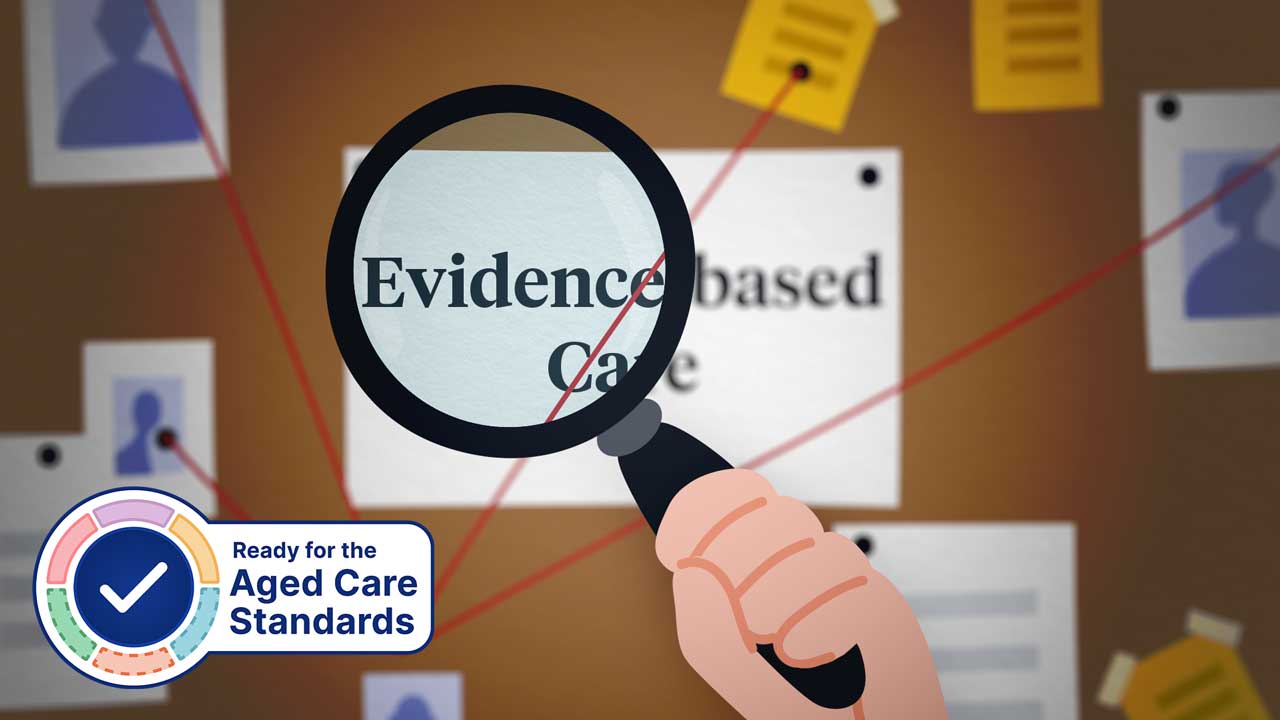About 40% of adult patients are provided care that isn’t based on current evidence. Some of this care is ineffective, unnecessary and potentially even harmful (Health.vic 2021).
Evidence-based care is a key component of effective and multidimensional care provision. So, how can it be implemented?
What is Evidence-based Care?
Evidence-based care (also known as evidence-based practice) is the use of research evidence, in tandem with clinical expertise and patient values, to inform clinical decisions (Health.vic 2021).
Specifically, evidence-based care is an integration of:
- Best available research evidence
- Staff skills, training and experience (clinical expertise)
- The patient’s values and circumstances (e.g. financial situation)
- The practice context in which healthcare staff are working.
(Turner 2023)
What Are the Benefits of Evidence-based Care?
- Improved patient outcomes
- Improved quality of life for patients
- Staff are encouraged to reflect upon whether they can perform tasks more effectively
- Improved allocation of resources
- Improved staff productivity
- Reduced costs
- Staff can stay updated about new protocols
- Patients can participate in their care by voicing their concerns, values and preferences.
(Turner 2023; Health.vic 2021; ANA 2023)

Evidence-based Care in the National Safety and Quality Health Service Standards
Evidence-based care is outlined in Action 1.27 of the National Safety and Quality Health Service Standards, under Standard 1: Clinical Governance.
This action aims to ensure healthcare workers use the best available evidence in their practice. Health service organisations should:
- Allow staff to easily access best-practice guidelines, integrated care pathways, clinical pathways and decision support tools
- Support staff to use the best available evidence in their provision of care, including clinical care standards developed by the Australian Commission on Safety and Quality in Health Care.
(ACSQHC 2022)
Evidence-based Practice Under the Strengthened Aged Care Quality Standards
The strengthened Aged Care Quality Standards use the term ‘contemporary, evidence-based practice’ to describe evidence-based care.
The Standards outline many areas in which contemporary, evidence-based practice should be used in aged care, including:
- The provision of culturally safe, trauma aware and healing informed care
- The implementation of a quality system
- The organisation’s policies and procedures
- Timely recognition and care of older people with dementia
- Infection prevention and control
- Antimicrobial stewardship systems
- Performing medication reviews
- Comprehensive clinical assessment
- The implementation of systems to promote clinical safety
- Identifying changes in an older person’s health
- Ensuring safe eating, drinking and swallowing
- Continence care
- Falls prevention
- Maintaining nutrition and hydration
- Optimising mental health and wellbeing
- Pain management
- Pressure injury prevention
- Wound care
- Support of older people with sensory impairment
- Foods and drinks provided to older people.
(ACQSC 2024a-f)
What is Best Available Research Evidence?
The term best available research evidence refers to ‘clinically relevant research drawn from studies with the least possible bias’. In other words, it is the highest-quality research available (CIAP 2019).
In order to determine whether research is of sufficient quality to inform your clinical decision-making, you must consider:
- Validity: Is the research reliable?
- Impact: Are the results of the research clinically significant?
- Applicability: Is the research relevant and applicable to the patient and their situation?
(Turner 2023)
Staff should have access to resources that reflect best practice-evidence. These may be in the form of:
- Best-practice guidelines
- Integrated care pathways
- Clinical pathways
- Decision support tools
- Clinical care standards.
(ACSQHC 2022)
The Hierarchy of Evidence

Some types of research are considered more reliable than others.
The most suitable type of evidence depends on the kind of question you are answering. For further advice, the National Health and Medical Research Council (NHRMC) has devised a detailed table listing evidence from most to least reliable for different kinds of research questions:
| Level | Intervention | Diagnosis | Prognosis | Aetiology | Screening |
|---|---|---|---|---|---|
| I | Systematic review of Level II studies | Systematic review of Level II studies | Systematic review of Level II studies | Systematic review of Level II studies | Systematic review of Level II studies |
| II | Randomised controlled trial | Study of test accuracy with an independent, blinded comparison with a valid reference standard, among consecutive patients with a defined clinical presentation | Prospective cohort study | Prospective cohort study | Randomised controlled trial |
| III-1 | Pseudorandomised controlled trial | Study of test accuracy with an independent, blinded comparison with a valid reference standard, among consecutive patients with a defined clinical presentation | All or none | All or none | Pseudorandomised controlled trial |
| III-2 | Comparative study with concurrent controls:
|
Comparison with reference standard that does not meet the criteria required for Level II and III-1 | Analysis of prognostic factors amongst untreated control patients in a randomised controlled trial | Retrospective cohort study | Comparative study with concurrent controls:
|
| III-3 | Comparative study without concurrent controls:
|
Diagnostic case-control study | Retrospective cohort study | Case-control study | Comparative study without concurrent controls:
|
| IV | Case studies with either post-test or pre-test/post-test | Study of diagnostic yield (no reference standard) | Case series, or cohort study of patients at different stages of disease | Crosssectional study | Case studies |
(Adapted from NHMRC 2009)
The 5 Steps of Evidence-based Care
The ‘5A’s Cycle’ (ask, acquire, appraise, apply and audit) is the model used to incorporate evidence into practice.
| 1 | Ask |
|
| 2 | Acquire |
|
| 3 | Appraise | Assess the evidence for validity, impact and applicability using the following questions:
|
| 4 | Apply |
|
| 5 | Audit |
|
(Turner 2023)
Supporting Evidence-based Care

In order to support staff to deliver evidence-based care, health service organisations should:
- Utilise clinical care standards
- Hold healthcare staff accountable for their practice
- Quickly identify and manage any harmful practices that are observed
- Monitor compliance with and any deviations from evidence-based practice
- Designate committees or individuals responsible for approving and reviewing resources based on best available evidence
- Enable peer-based feedback about compliance with and deviation from evidence-based practice
- Inform staff if an unwarranted deviation from evidence-based practice has been observed
- Conduct audits to determine what proportion of care is adhering to evidence-based resources.
(ACSQHC 2022)
Conclusion
By using clinical expertise, patient preferences and practice context to inform clinical decisions alongside the best, most reliable research available, you can ensure patients receive appropriate and high-quality care.
Test Your Knowledge
Question 1 of 3
What is the correct order of the 5A’s cycle?
Topics
References
- Aged Care Quality and Safety Commission 2024a, Standard 1: The Individual, Australian Government, viewed 15 April 2024, https://www.health.gov.au/resources/publications/strengthened-aged-care-quality-standards-august-2025?language=en
- Aged Care Quality and Safety Commission 2024b, Standard 2: The Organisation, Australian Government, viewed 15 April 2024, https://www.health.gov.au/resources/publications/strengthened-aged-care-quality-standards-august-2025?language=en
- Aged Care Quality and Safety Commission 2024c, Standard 3: Care and Services, Australian Government, viewed 15 April 2024, https://www.health.gov.au/resources/publications/strengthened-aged-care-quality-standards-august-2025?language=en
- Aged Care Quality and Safety Commission 2024d, Standard 4: The Environment, Australian Government, viewed 15 April 2024, https://www.health.gov.au/resources/publications/strengthened-aged-care-quality-standards-august-2025?language=en/environment
- Aged Care Quality and Safety Commission 2024e, Standard 5: Clinical Care, Australian Government, viewed 15 April 2024, https://www.health.gov.au/resources/publications/strengthened-aged-care-quality-standards-august-2025?language=en
- Aged Care Quality and Safety Commission 2024f, Standard 6: Food and Nutrition, Australian Government, viewed 15 April 2024, https://www.health.gov.au/resources/publications/strengthened-aged-care-quality-standards-august-2025?language=en/food-and-nutrition
- American Nurses Association 2023, What Is Evidence-Based Practice in Nursing?, ANA, viewed 15 April 2024, https://www.nursingworld.org/content-hub/resources/workplace/evidence-based-practice-in-nursing/
- Australian Commission on Safety and Quality in Health Care 2022, Action 1.27 Evidence-based Care, Australian Government, viewed 15 April 2024, https://www.safetyandquality.gov.au/standards/national-safety-and-quality-health-service-nsqhs-standards/clinical-governance-standard/clinical-performance-and-effectiveness/action-127
- Clinical Information Access Portal 2019, Introduction to Evidence-Based Practice and CIAP, CIAP, viewed 15 April 2024, https://www.ciap.health.nsw.gov.au/training/ebp-learning-modules/module1/
- National Health and Medical Research Council 2009, Appendix F: Levels of Evidence and Recommendation Grading, Australian Government, viewed 15 April 2024, https://www.nhmrc.gov.au/sites/default/files/images/appendix-f-levels-of-evidence.pdf
- Turner, M 2023, Evidence-Based Practice in Health, University of Canberra, viewed 15 April 2024, https://canberra.libguides.com/evidence
- Health.vic 2021, Implementing Evidence-Based Practice, Victoria State Government, viewed 15 April 2024, https://www.health.vic.gov.au/patient-care/implementing-evidence-based-practice
 New
New 
